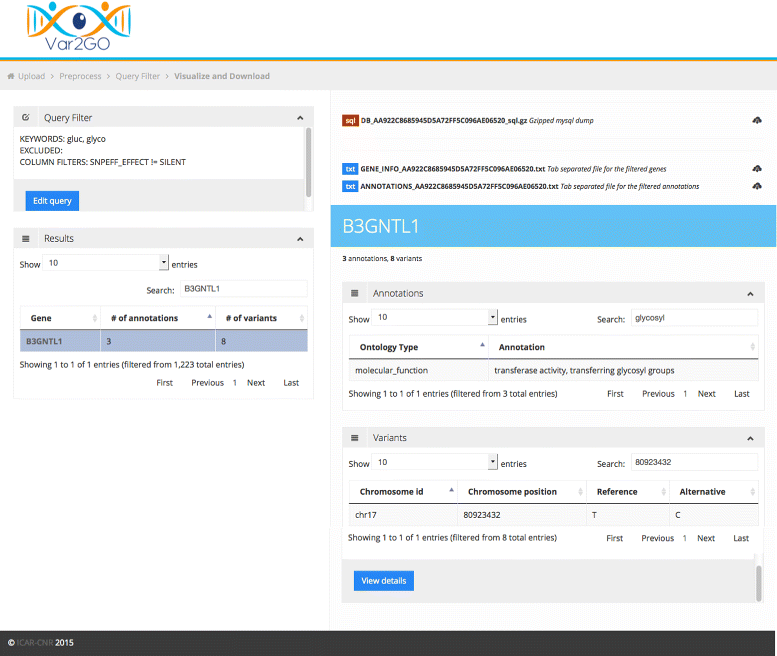Var2GO: a web-based tool for gene variants selection
- PMID: 28185576
- PMCID: PMC5123234
- DOI: 10.1186/s12859-016-1197-0
Var2GO: a web-based tool for gene variants selection
Abstract
Background: One of the most challenging issue in the variant calling process is handling the resulting data, and filtering the genes retaining only the ones strictly related to the topic of interest. Several tools permit to gather annotations at different levels of complexity for the detected genes and to group them according to the pathways and/or processes they belong to. However, it might be a time consuming and frustrating task. This is partly due to the size of the file, that might contain many thousands of genes, and to the search of associated variants that requires a gene-by-gene investigation and annotation approach. As a consequence, the initial gene list is often reduced exploiting the knowledge of variants effect, novelty and genotype, with the potential risk of losing meaningful pieces of information.
Results: Here we present Var2GO, a new web-based tool to support the annotation and filtering of variants and genes coming from variant calling of high-throughput sequencing data. Var2GO permits to upload either the unprocessed Variant Calling Format file or a table containing the annotated variants. The raw data undergo a preliminary step of variants annotation, using the SnpEff tool, and are converted to a table format. The table is then uploaded into an on the fly generated database. Genes associated to the variants are automatically annotated with the corresponding Gene Ontology terms covering the three GO domains. Using the web interface it is then possible to filter and extract, from the whole list, genes having annotations in the domain of interest, by simply specifying filtering parameters and one or more keywords. The relevance of this tool is demonstrated on exome sequencing data.
Conclusions: Var2GO is a novel tool that implements a topic-based approach, expressly designed to help biologists in narrowing the search of relevant genes coming from variant calling analysis. Its main purpose is to support non-bioinformaticians in handling and processing raw variant calling data through an intuitive web interface. Furthermore, Var2GO offers a complete pipeline that, starting from the raw VCF file, allows to annotate both variants and associated genes and supports the extraction of relevant biological knowledge.
Keywords: Annotation; Gene ontology; Gene variants; Next generation sequencing; Web-based tool.
Figures

Similar articles
-
VCF-Miner: GUI-based application for mining variants and annotations stored in VCF files.Brief Bioinform. 2016 Mar;17(2):346-51. doi: 10.1093/bib/bbv051. Epub 2015 Jul 25. Brief Bioinform. 2016. PMID: 26210358 Free PMC article.
-
DaMold: A data-mining platform for variant annotation and visualization in molecular diagnostics research.Hum Mutat. 2017 Jul;38(7):778-787. doi: 10.1002/humu.23227. Epub 2017 May 30. Hum Mutat. 2017. PMID: 28397319
-
VCF.Filter: interactive prioritization of disease-linked genetic variants from sequencing data.Nucleic Acids Res. 2017 Jul 3;45(W1):W567-W572. doi: 10.1093/nar/gkx425. Nucleic Acids Res. 2017. PMID: 28520890 Free PMC article.
-
Variant effect predictors: a systematic review and practical guide.Hum Genet. 2024 May;143(5):625-634. doi: 10.1007/s00439-024-02670-5. Epub 2024 Apr 4. Hum Genet. 2024. PMID: 38573379 Free PMC article.
-
Variation Interpretation Predictors: Principles, Types, Performance, and Choice.Hum Mutat. 2016 Jun;37(6):579-97. doi: 10.1002/humu.22987. Epub 2016 Apr 15. Hum Mutat. 2016. PMID: 26987456 Review.
Cited by
-
BITS 2015: the annual meeting of the Italian Society of Bioinformatics.BMC Bioinformatics. 2016 Nov 8;17(Suppl 12):396. doi: 10.1186/s12859-016-1187-2. BMC Bioinformatics. 2016. PMID: 28185548 Free PMC article.
-
Variant Impact Predictor database (VIPdb), version 2: Trends from 25 years of genetic variant impact predictors.bioRxiv [Preprint]. 2024 Jun 28:2024.06.25.600283. doi: 10.1101/2024.06.25.600283. bioRxiv. 2024. Update in: Hum Genomics. 2024 Aug 28;18(1):90. doi: 10.1186/s40246-024-00663-z. PMID: 38979289 Free PMC article. Updated. Preprint.
-
Whole-Exome Sequencing (WES) Reveals Novel Sex-Specific Gene Variants in Non-Alcoholic Steatohepatitis (MASH).Genes (Basel). 2024 Mar 13;15(3):357. doi: 10.3390/genes15030357. Genes (Basel). 2024. PMID: 38540416 Free PMC article.
-
Variant Impact Predictor database (VIPdb), version 2: trends from three decades of genetic variant impact predictors.Hum Genomics. 2024 Aug 28;18(1):90. doi: 10.1186/s40246-024-00663-z. Hum Genomics. 2024. PMID: 39198917 Free PMC article.
References
-
- Cingolani P, Platts A, Wang LL, Coon M, Nguyen T, Wang L, Land SJ, Lu X, Ruden DM. A program for annotating and predicting the effects of single nucleotide polymorphisms, SnpEff: Snps in the genome of drosophila melanogaster strain w1118; iso-2; iso-3. Fly. 2012;6(2):80–92. doi: 10.4161/fly.19695. - DOI - PMC - PubMed
Publication types
MeSH terms
Substances
LinkOut - more resources
Full Text Sources
Other Literature Sources
Research Materials

